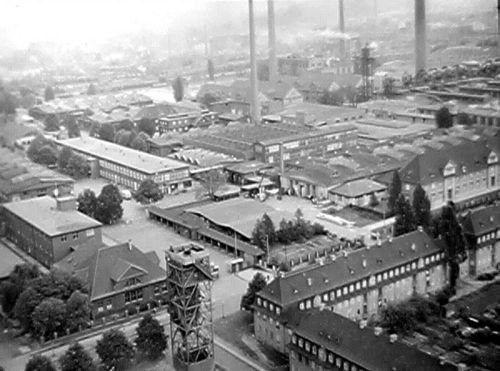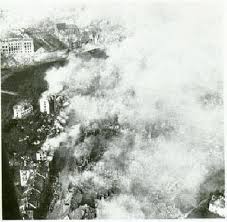Bombardment of Kassel, 27-28 August 1942
Introduction
German cities suffered large scale bombing by the Allied Air Force during the Second World War. The big bombing raids on Berlin, Hamburg and especially Dresden are well known. But other towns also suffered severe air attacks. For example, Kassel, situated in central Germany in the state of Hessen. This city was an important target and was repeatedly attacked from the air. A bombardment of Kassel was a dangerous operation for the bomber crews as well. For example, they suffered heavy losses during the night of 27-28th August 1942. More than 10 per cent of the bomber force, 31 aircraft, were lost that night.
Important target
Kassel was a medium sized city with only 250.000 inhabitants. However, the city was a high profile target for RAF Bomber Command. As well as being the capital of the provinces of Hessen-Nassau and Keur-Hessen, the city contained some important industrial targets. The Fieseler aircraft plant, which built the Messerschmidt Bf109 and Focke-Wulf Fw190, was based in Kassel. Besides that Dornier Do17 bombers as well as Tiger and Panzer tanks were built at the Henschel armaments works. The city also contained locomotive, engine and motor transport plants. The military headquarters (Wehrkreis IX) were located in Kassel and because of its location in central Germany it was an important interchange for railways and roads.
From the outbreak of the Second World War it took two more years before Bomber Command attacked the city. It was the target for a bombing raid for the first time during the night of 8-9 September 1941. 95 aircraft carried out an attack on the Henschel armaments works and a locomotive plant. Only two factory buildings were severely damaged, although the crews claimed to have carried out accurate bombing. Seventy houses were also hit. The insignificant results were characteristic of the inefficiency of the air offensive during the first stage of the war. In the following months it became clear the tactics of precise bombing on military and industrial targets did not had the desired effect. Therefore another commander was appointed in early 1942. Air Marshal Sir Richard Peirse was replaced by Air Chief Marshal Sir Arthur Harris. Since then a new bombing tactic called ‘area-bombing’ was used. These attacks were not carried out against military or industrial targets alone, but carried out on a large area surrounding these targets, such as a city block or an entire city.
It took some time before Harris sent his bomber force to Kassel. For the night of 27-28 August 1942 he assembled an attacking force of 306 aircraft, which was composed of the following:
No.1 Group – 97 bombers
No.3 Group – 93 bombers
No.5 Group – 80 bombers
Pathfinder Force – 36 bombers
It was only the third time Air Vice Marshall Donald Bennett’s Pathfinder Force was part of the bomber force. Thirty-six of these ‘pathfinders’ had to identify the most important targets like factory buildings and military objects with flares. At the briefing the crews were told to expect the target to be heavily defended because of its industrial importance. The weather conditions – good visibility and light wind – would make it possible for them to bomb the targets successfully. The attacking force was split into three sections. The first section contained the pathfinders. They had to illuminate the most important targets in the city center – the Henschel armaments works (codenamed Bream), the marshalling yard (codenamed Smolt) and the surrounding city block – with their flares in 5 minutes. Hereafter the aircraft of the second section had 20 minutes to drop their bombs on these targets. The last section had 15 minutes to carry out the bombardment. Four specially picked crews had to observe the results of the attack after 35 minutes so they could report the effects of the raid. These four crews were picked from No.12, 103, 150 and 305 Squadron.
The attack
Preceded by the pathfinders, the 270 bombers took off from their airfield in England around 8:30 PM. No.115 and No.142 Squadron supplied the most aircraft (fifteen each) for the attack. Wellington Z1469 (142 Squadron) had taken off from RAF Grimsby. Sergeant Norman Child recalls: "we were routed in ten miles south of Münster. Flak ships were very active off the Dutch coast. There was no trouble so far. Visibility good. Approaching target and all hell let loose approximately ten miles ahead. Very heavy barrage! Town ringed with guns and searchlights. Several kites had been hit and gone down."
Only a small number of aircraft had to abort the mission on route to Kassel or had been shot down before they reached the target. The bomber force arrived over Kassel around midnight. The pathfinders were able to illuminate the area well. They had dropped 51 flares, their best effort so far. Hereby, the remainder of the attacking force knew exactly where to drop their bomb load and many crews claimed to have hit their targets. But they also experienced that the warnings for the city's heavy defenses at the briefing were justified. Child: "for a few minutes everything was chaos. Searchlights and flak were forcing us lower and lower. The flak was so bad and the searchlights so blinding! Front and rear turrets were firing at the searchlights and between them they accounted for five." Flight Sergeant Leslie Seamark's Wellington was caught by several searchlights. His Observer, Sergeant Richard Lind, later reckoned there were 15-20 of them. The aircraft was subjected to intense heavy flak. Seamark succeeded in escaping German defenses, but the crew experienced two very scary moments. First, when the pilots oxygen mask was holed by a bullet from light flak. Surprisingly Seamark only suffered a slight graze on his chin. Moments later, the fuselage of the Wellington was damaged by impact with a factory chimney. The badly damaged bomber had to fly back to England at a precarious height. Meanwhile, it was constantly fired at by flak. However Seamark managed to reach Grimsby at 2:30 AM. During the debriefing the crew admitted it had been a very daunting trip.
Other crews were less fortunate. Many bombers were shot down by the heavy flak or were so badly damaged that they crashed on the homeward journey. Besides that, the German night-fighters also had the advantage of the clear sky that night. No less than thirteen aircraft were intercepted and shot down. Stirling W7624 of No.15 Squadron was one of them. This machine was attacked over Bentelo (province of Overijssel) by Oberleutnant Viktor Bauer and crashed in a fireball. Hendrik Kleinsman lived in Bentelo. He recalls: "it was a giant ball of fire. The huge bomber hit the ground with such force that its cockpit and engines were driven up to 15 meters into the sodden earth." The impact of the crash was so powerful and the fire was so intense that only one crew member, New Zealander Glen Smith, could be identified.
Casualties and damage
31 aircraft failed to return, more than 10 per cent of the bomber force. Losses were heavy for 142 Squadron in particular. Five (Wellington Z1266*, Z1338, Z1396, Z1411 and Z1424) out of fifteen aircraft deployed on this operation were lost, all from 'B-flight'. 25 airmen from the squadron were killed and five were taken prisoner of war. Norman Child's concludes: "Our aircraft looked a mess. Full of holes and big chunks off. The next day we discovered, to our horror, that of the six aircraft from 'B' Flight, our crew were the only survivors." In total, 154 allied airmen lost their lives during the operation on Kassel. Another 20 crew members were taken as prisoners of war and 15 men were able to evade capture by the Germans.
Widespread damage was caused in Kassel, although reports also state that many bombs fell outside the town, in fields and woods. Particularly the south-western part of the city was hit badly. 144 buildings were destroyed and 317 seriously damaged. 43 people were killed in the bombardment. The number of dead soldiers, 28, exceeded the number of civilians, 15. Besides that, 64 soldiers and 187 civilians were injured. All three factory buildings of the Henschel armaments works were among the severely damaged buildings.
During the remainder of the war Kassel was repeatedly attacked by the Allied Air Forces. It would take more than a year before Bomber Command would raid the city again. During the night of 3-4 October 1943, 547 aircraft bombed the city center. 569 bombers carried out another attack less than three weeks later (22-23 October). On 8 September 1944, 262 B-24's of the American 8th Air Force bombed the Henschel armaments works in daylight. The last large scale bombing of Kassel took place during the night of 8-9 March 1945, when 176 aircraft of Bomber Command were sent to the city. As well as these large attacks, the city also was repeatedly a target for diversion raids. These small scale operations were intended to divert attention from heavy raids on other cities.
* the tail gunner of Wellington Z1206, Sergeant Robert Roy Henderson, is also mentioned in the article about the crew of Wellington Z1321 who were killed in a crash near Vlaardingen.
Definitielijst
- Bomber Command
- RAF unit which controlled strategic and sometimes tactical bombing (as in Normandy)
- Flak
- Flieger-/Flugabwehrkanone. German anti-aircraft guns.
- Marshal
- Highest military rank, Army commander.
- offensive
- Attack on a smaller or larger scale.
- Pathfinder Force
- Unit flying ahead of the bombers to locate and mark the target with flares to enable the following bombers to drop their bombs at the pre-set time, height and course from the target.
- RAF
- Royal Air Force. British air force
- raid
- Fast military raid in enemy territory
- Squadron
- A military unit in the Belgian navy usually six to eight small ships operating together under one command. The smallest military unit in the Dutch air force of about 350 men. In most countries is the designation of a military unit thesize of a company. It is either an independent unit, such as a battery, or part of a bigger Calvary unit. In the air force it is the designation of a unit of aircrafts.
Images
Information
- Article by:
- Pieter Schlebaum
- Published on:
- 19-04-2014
- Last edit on:
- 30-09-2024
- Feedback?
- Send it!
Related sights
Related books
Sources
- BOWMAN, M., Bomber Command Reflections of War, Volume 2, Pen & Sword Books, Barnsley, 2012.
- CHORLEY, W.R., RAF Bomber Command Losses of the Second World War, 1942, Ian Allan Publishing, 1998.
- MIDDLEBROOK, M. & EVERITT, C., The Bomber Command War Diaries, Midland Publishing, 2011.
No.12 Squadron Operations Record Book
No.15 Squadron Operations Record Book
No.142 Squadron Operations Record Book
Results of Operations No.3 Group
Summary of raid orders for RAF Binbrook













